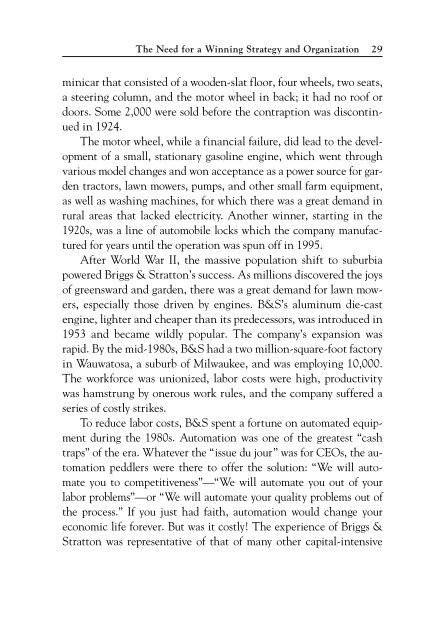The EVA Challenge: Implementing Value-Added Change in an ...
The EVA Challenge: Implementing Value-Added Change in an ...
The EVA Challenge: Implementing Value-Added Change in an ...
Create successful ePaper yourself
Turn your PDF publications into a flip-book with our unique Google optimized e-Paper software.
<strong>The</strong> Need for a W<strong>in</strong>n<strong>in</strong>g Strategy <strong>an</strong>d Org<strong>an</strong>ization 29<br />
m<strong>in</strong>icar that consisted of a wooden-slat floor, four wheels, two seats,<br />
a steer<strong>in</strong>g column, <strong>an</strong>d the motor wheel <strong>in</strong> back; it had no roof or<br />
doors. Some 2,000 were sold before the contraption was discont<strong>in</strong>ued<br />
<strong>in</strong> 1924.<br />
<strong>The</strong> motor wheel, while a f<strong>in</strong><strong>an</strong>cial failure, did lead to the development<br />
of a small, stationary gasol<strong>in</strong>e eng<strong>in</strong>e, which went through<br />
various model ch<strong>an</strong>ges <strong>an</strong>d won accept<strong>an</strong>ce as a power source for garden<br />
tractors, lawn mowers, pumps, <strong>an</strong>d other small farm equipment,<br />
as well as wash<strong>in</strong>g mach<strong>in</strong>es, for which there was a great dem<strong>an</strong>d <strong>in</strong><br />
rural areas that lacked electricity. Another w<strong>in</strong>ner, start<strong>in</strong>g <strong>in</strong> the<br />
1920s, was a l<strong>in</strong>e of automobile locks which the comp<strong>an</strong>y m<strong>an</strong>ufactured<br />
for years until the operation was spun off <strong>in</strong> 1995.<br />
After World War II, the massive population shift to suburbia<br />
powered Briggs & Stratton’s success. As millions discovered the joys<br />
of greensward <strong>an</strong>d garden, there was a great dem<strong>an</strong>d for lawn mowers,<br />
especially those driven by eng<strong>in</strong>es. B&S’s alum<strong>in</strong>um die-cast<br />
eng<strong>in</strong>e, lighter <strong>an</strong>d cheaper th<strong>an</strong> its predecessors, was <strong>in</strong>troduced <strong>in</strong><br />
1953 <strong>an</strong>d became wildly popular. <strong>The</strong> comp<strong>an</strong>y’s exp<strong>an</strong>sion was<br />
rapid. By the mid-1980s, B&S had a two million-square-foot factory<br />
<strong>in</strong> Wauwatosa, a suburb of Milwaukee, <strong>an</strong>d was employ<strong>in</strong>g 10,000.<br />
<strong>The</strong> workforce was unionized, labor costs were high, productivity<br />
was hamstrung by onerous work rules, <strong>an</strong>d the comp<strong>an</strong>y suffered a<br />
series of costly strikes.<br />
To reduce labor costs, B&S spent a fortune on automated equipment<br />
dur<strong>in</strong>g the 1980s. Automation was one of the greatest “cash<br />
traps” of the era. Whatever the “issue du jour” was for CEOs, the automation<br />
peddlers were there to offer the solution: “We will automate<br />
you to competitiveness”—“We will automate you out of your<br />
labor problems”—or “We will automate your quality problems out of<br />
the process.” If you just had faith, automation would ch<strong>an</strong>ge your<br />
economic life forever. But was it costly! <strong>The</strong> experience of Briggs &<br />
Stratton was representative of that of m<strong>an</strong>y other capital-<strong>in</strong>tensive

















